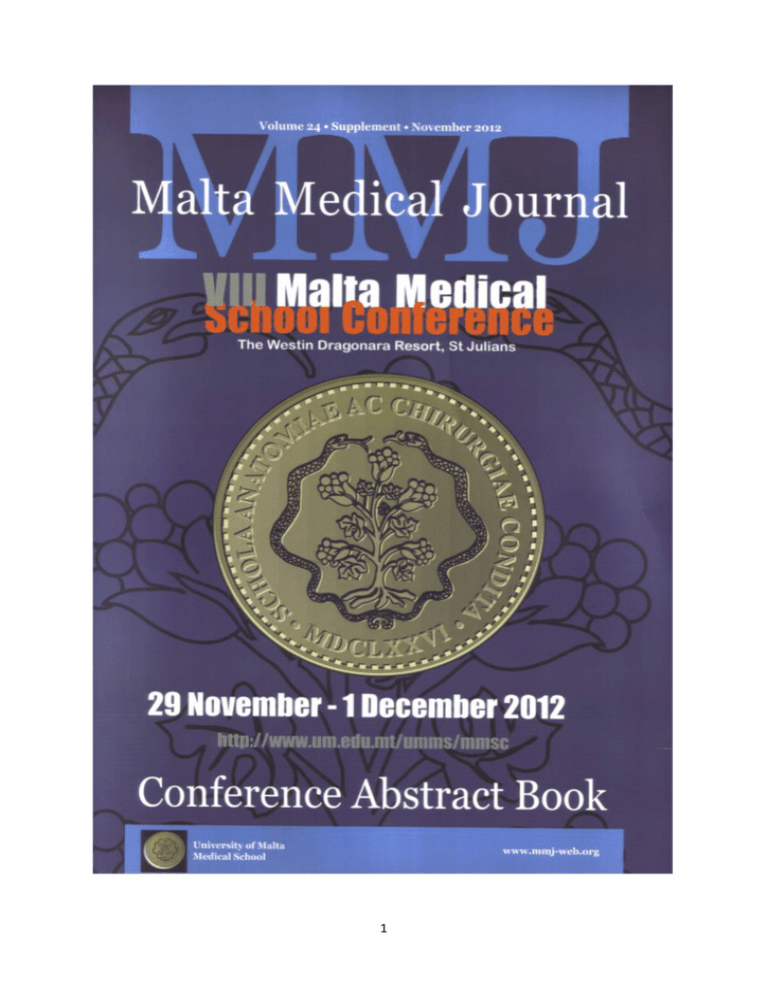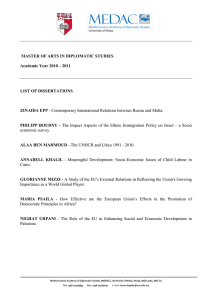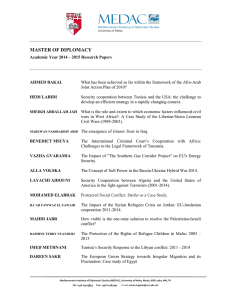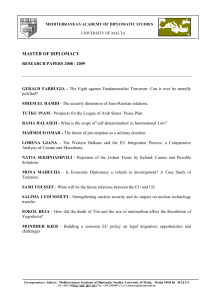1
advertisement

1 VIII Malta Medical School Conference 29th November – 1 December 2012 Session 7C: Medical Humanities Chairpersons: Prof. Claire Vassallo and Dr. Bridgette Ellul OP7.195 The Might of Healing Springs’: Writing, Health and Disease in Shelley (and Mary Shelley) M. O’Neill OP7.196 Feminisation and the Maltese medical profession J.M. Cacciottolo1, C. Vassallo2, G.M. Martin3 1 Department of Medicine, University of Malta, Humanities and Medical Science Programme, 3 University of Malta, Department of Sociology, University of Malta 2 Department of English Studies Shelley figures prominently in any account of literature’s relationship with health and diagnosis of illness. We are more used to thinking of Keats as a poet-physician, but, after expulsion from Oxford, Shelley briefly considered training as surgeon and attended a course at St Bartholomew’s Hospital. Throughout his turbulent and creative life, he was passionately interested in theories about the causation of disease and the very nature of existence. This talk will reflect on his explorations in a range of works, including ‘Prometheus Unbound’ and ‘Adonais’ (and glancing at Mary Shelley’s cognate enquiries in ‘Frankenstein’); in particular, it will look at Shelley’s understanding of the relationship between life and death, and matter and spirit. Shelley raises fascinating questions about the value -- and potential limits -of the new cross-disciplinary enterprise of medical humanities. The paper will argue that Shelley’s poetry demands we consider literature and medical humanities as good neighbours rather than identical twins. Participation of women within the medical profession in Malta is a relatively recent phenomenon and despite the fact that a medical school has been in existence since 1676, the first female doctor qualified in 1925. Until the early 1980’s, numbers of women qualifying were very small. This changed suddenly and in 1985, a watershed year, women accounted for 28% of doctors qualifying. In 2004, the male to female ratio reversed for the first time, and in 2008 women accounted for 62% of medical graduates. This demographic profile is consistent and mirrors that obtaining in other European countries, where reasons for this demographic shift included decline in prejudice and discrimination. It is generally also a reflection of changing community-specific social milieu. Review of pertinent literature suggests that women tend to gravitate towards certain specialties. Family medicine, paediatrics and obstetrics/gynaecology possibly afford closer interpersonal relationships and it is possible that 2 women are generally more empathic and personalized in their approach to medical problems with strong psychosocial profiles. This may, however, be an inaccurate stereotype and the reasons may have more to do with flexible work patterns often sought by working mothers. In Malta, it may be that this significant change in gender composition of the medical profession is already affecting the organization and delivery of healthcare. The issues raised by feminisation have immediate and practical dimensions, given the rapid changes ongoing in society generally, and particularly in healthcare and the practice of medicine. Any human resources planning and future strategies for delivery of healthcare will need to take into account the effects that result from changes in gender composition of the medical workforce with the possibility of obligatory shared parental leave introduced as a means of creating an equal professional playing field. There is need for accurate information about the current role and level of utilization of women as a workforce in the delivery of healthcare and actual medical practice in Malta. Studies need to evolve in order to explore possible reasons for hurdles that women come across in their quest for medical educational attainment both at undergraduate and at postgraduate level. In tandem, it also becomes necessary to study patients’ viewpoints regarding gender issues in their interactions with male and female doctors. malformations. High fertility was strongly desired being viewed as an enrichment of the extended family group in both nomadic and farming societies. In spite of this, high parity was not the norm with individual women generally having less than seven offspring as a result of the “conceptionpregnancy-lactation” cycles within a limited reproductive period. Infertility was considered a punishment and drastic measures such as the use of surrogacy, contributory insemination and fertility-promoters such as mandrake were resorted to. In spite of this, there were occasions when attempts were made to prevent a pregnancy using natural or surgical means – coitus interruptus and sterilization. Miscarriages were believed to be caused by physical trauma; while malformations were believed to be due to shape associations. OP7.198 After Posthumanism: medicine and twentyfirst century literature I. Callus Department of English, Univeristy of Malta, Msida ‘Medicine’ is the title of Granta 120 (2012), with this recent issue of the literary magazine confirming the irrepressibility of the medicine/humanities interface in contemporary literature and art. This paper takes its cue from this special issue to review how representations of that interface have changed over the last ten years. Through references to David Eagleman’s Sum/among other works, the paper argues that there has been a change in tone from from a rather sensationalist pitching of transhumanism to more sober depictions of the potential of biotechnology within posthumanist thought. In particular, the paper discusses the notion of predictive art and its relevance to the medical humanities and to medical contexts more broadly. OP7.197 A gynaecologist looks at the Torah C. Savona-Ventura Department of Obstetrics and Gynaecology, University of Malta Medical School, Msida. The books of the Torah are a compendium of Judaism’s founding legal and ethical religious texts. They have a wealth of reflections that deal with the various human lifecycles including the reproductive cycle as perceived by human society at the time, thus looking at the issues relating to fertility/infertility and contraception; and on concepts relating to aetiology of miscarriages and 3 overcome the problem of CPD may become available with time. In a 24th century setting, a Star Trek member of the crew Ensign Wildman delivering her infant interspecies Human- Ktarian child experiences difficulties related to obstructed labour. The Emergency Medical Hologram (EMH) managing the delivery decides that immediate delivery was necessary and locks onto the baby’s coordinates, initiates umbilical separation and energises foetal transport. The female HumanKtarian child materialises in the bio-crib suffering from the minor complication of slight haemocythemic imbalance managed by stabilising the cell membranes with osmotic pressure therapy. REV02 Beam me out Scotty! – an alternative to Caesarean section C. Savona-Ventura1, V. Grech2 1 Department of Obstetrics & Gynaecology, University of Malta Medical School, Msida, 2 Department of paediatrics, University of Malta Medical School, Msida In the majority of cases, the natural tendency in foetal development is to produce a child that can pass through the mother’s birth canal without problems – a child that is proportionate in size to the maternal pelvic dimensions. However, instances do occur where the foetus in utero has bigger dimensions that the optimum either because the child is too big or because of a congenital anomaly or because the mother’s pelvis is exceedingly small. This leads to cephalopelvic disproportion (CPD) which if unmanaged would result in foetal and maternal death. The complication of obstructed labour has been a problem faced by parturient mother and their carers throughout the ages. In antiquity, destructive instruments were designed to help reduce the size of the foetal head to allow for delivery. Soranus of Ephesus (AD 98-138) described seven different types of embryotomy instruments. The use and availability of such instruments continued well into the early 20th century. Borderline CPD was managed by rotational and traction instruments that were introduced in obstetric practice in the 17th century - these gave rise to modern forceps and ventouse forming part of modern-day obstetric armamentarium. The only modern safe for foetus and mother resort to absolute CPD is however Caesarean section. Abdominal delivery of the foetus from a recently deceased mother has a long history and is even mentioned in Greek mythology (sive the abdominal birth of Asclepius performed by the deity Apollo while the mother Coronis was being burned on the funeral pyre). The first documented Caesarean section of a live woman in Europe appears to have been performed around 1500 by Jakob Nufer, a Swiss pig-gelder. Caesarean section in the 21st century has become the mainstream management for many obstetric problems. Alternative delivery methods to OP8.214 The changing faces of future doctors: reflections of contemporary prospective patients in Star Trek over four decades V. Grech The Humanities and Medical Science Programme, University of Malta, Msida Science fiction is ubiquitous in everyday life, and Star Trek (ST) has become part of popular culture. Doctors play important roles in these episodes. This paper explores depictions of these individuals over the four decades since the inception of the original series. ST demonstrates that doctors have reflected the shifting expectations of the general public in that medics have morphed from an oldstyle country doctor, to a supermom, to a genetically engineered human, to a sentient, computer-generated hologram and to an alien who uses also uses natural healing methods. Doctors are expected to provide total accessibility, the ability to utilise natural remedies when possible, compassion and unstinting commitment to their patients and their profession, infallibility and broad skills with flexibility that allows them to deal with virtually anything, in anything. These capacities appear desirable even if the traditional doctor is replaced by a machine, a warning that it would behove the profession to heed. 4


